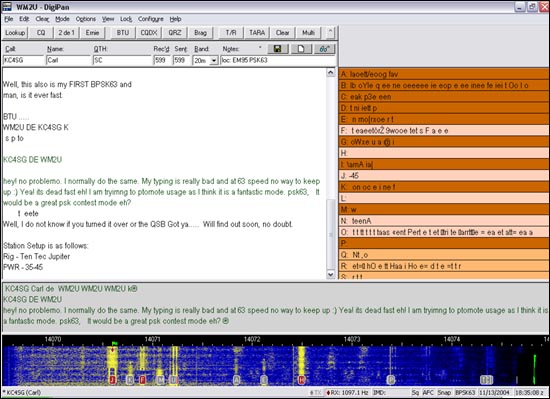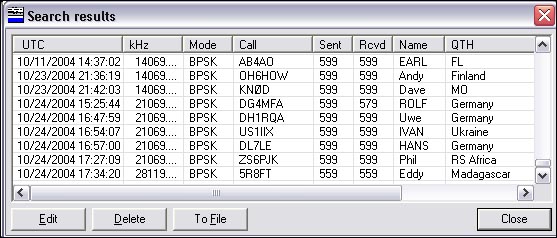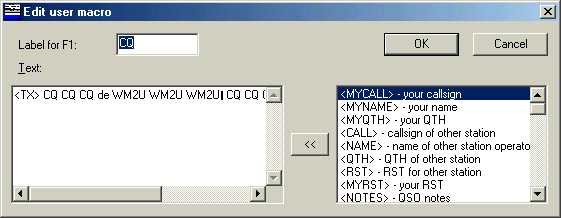
| Digipan 2.0 by Ernie Mills, WM2U. Please print this article and use it as a hand out at Club talks and lectures |
tnx Dany Surquin, in .pdf format ON4NB or in text http://www.on4nb.be/digipan.htm
|
Possibly regarded as the PSK standard interface for PSK31 and PSK63 operation. It is the result of a joint effort between Skip Teller, KH6TY and Nick Fedoseev. UT2UZ. This is a very easy program to download, install, configure and operate. It is well supported and would you believe it is Freeware. |

|
A very nice
addition to this release is the Lookup
button, which even if you are in QSO, will take you directly to QRZ or
Hamcall. This will display the information on the Call Sign that you
have entered in the Log Bar. Very handy eh? To
configure this click on Options | Call lookup at.. and
select your choice of providers. This button is actually a Macro and
takes up the F1 spot. You can change it. The other macro Buttons are
discussed below. |
|
Ok, lets get this show on the road. First off download the software from
http://www.digipan.net/ , click on the
download link, and install
it. You have interfaced the Computer to the Radio eh? If not go to my hookup page at http://www.qsl.net/wm2u/interface.html and do it. Fire up the program and you will see a window similar to the above. Click on Configure
| Personal Data, and fill in your Call Sign, Name, and QTH. Now go to View and make sure all the options are selected
except for underline sent text, then click on Options and select AFC, Snap and Rx. In the Mode menu item check BPSK. In the
Clear menu you will find that you can selectively clear any or all of the windows.
These settings are just for you to get up and running fast. You should
go back later to select the various options to your preferences. Snap
will make the cursor 'snap' to the closest signal.
Note de ON4NB :
If you use a portable PC which does not possess a port COM RS232,
you will have to connect at first an interface « USB towards RS232 »
before being able to settle this parameter - if the port COM is
not connected or not recognized, Digipan will give you an opening "
error COM1 " |
 |
This waterfall screen shot is an example of a badly overdriven sound card. Notice that you can count out to the 15th harmonic and it is splattering over 500Hz taking out at least 6 PSK31 QSO's |
| Click the Waterfall Drive in the Configure menu and set the microphone slider to about 75%. Now, into a dummy load, click the T/R button and send out a signal. Click on the Transmitter Drive also in the Configure menu and increase the Volume, and/or Wave slider, while watching the ALC indicator on the rig. As soon as the ALC starts to read, STOP. This is the maximum power output you can use to maintain a clean signal. On my system this will typically be between 50 and 70 watts output. | |
 |
This waterfall screen shot shows a Pactor signal that fired up directly on top of my PSK QSO, completely wiping out the Rx text. Some sick puppies out there eh!. |
| You can see that the Pactor signal could wipe out about 4 PSK QSO's. but the switching clicks are covering the complete display of the waterfall indicator from one side to the other. Please make sure your signals are not causing this type of splatter. | |

| You will notice, just below the log buttons and to the right a bit, there are three buttons we have not talked about. These are your logger control buttons. The small "*" at the left of these shows you that you have not entered the latest info into the log yet. To do this simply click the Save button. The button with the eyeglasses on pops up the logger editing window, and from here you can Delete, Edit or Send all or some of the log to a file. This file can then be easily printed out or e-mail mailed.. |

Before I let you go, just a quick word about Macros. Writing Macros in Digipan could not have been made any easier. There are twelve buttons along the top of the main window. These are the F(n) macro buttons and if you click the small button marked with "^" you will be presented with twelve Cntl F(n) macro buttons. If you right click on any one of them, an edit window will open. |
Under Configure/Waterfall
drive, adjust the appropriate Windows Recording Control level controls for a
speckled blue background on the Spectrum Window, which is the window on the bottom of the DigiPan screen with the calibrated scale across the
top. If you are using Windows 95, to get to the Recording Control window, select
Options/Properties/Adjust volume for recording and press OK. Be sure either
Microphone or Line level controls are checked for display.
Press the T/R button on the Control Bar, and under Configure/Transmitter
drive, adjust the Volume and Wave level controls
so that the ALC is just sat on Zero. Once the
ALC reads you could be distorting the output. Press the T/R button again to stop transmission and return to Receive mode. |
| It is strongly recommended that the operation of PSK31
and PSK63 are practiced in separate bands. There was a problem
when a few of the software packages that made it possible to switch between
PSK31 and PSK63 on the fly, caused bad QRM to adjacent QSO's when switched
from PSK31 to PSK63. If it is necessary to run switching tests, use the
PSK63 section. It is therefore recommended that the following be adopted. The calling frequencies for PSK31, that have been decided upon for the time being are: 1838.15kHz, 3580.15kHz, 7070.15kHz, 7035.15kHz, 14070.15kHz, 21070.15kHz, 28120.15kHz, 50.290mHz, 144.144mHz, 222.07mHz, 432.2mHz, 909mHz and 10137.15kHz, 18100.15kHz and 24925kHz suggested for the WARC Bands. |
| The calling frequencies
for PSK63, that have been decided upon for the time being are: 1838.15kHz, 3582.5kHz, 7072.5kHz, 7037.5kHz, 14072.5kHz, 21072.5kHz, 28122.5kHz, 50.290mHz, 144.144mHz, 222.07mHz, 432.2mHz, 909mHz and 10142.5kHz, 18102.5Hz and 24925kHz suggested for the WARC Bands. |
|
Use the widest IF filter
available. If the IF filter is 3.5 kHz wide, stations between 14.070 and 14.0730 should be workable. If the IF filter is only 2.5 kHz wide, stations between 14.070 and 14.072 will be workable. Even though it may be possible to copy strong stations somewhat outside the filter bandwidth, attempted transmission too far from the
filter passband will usually result in operation at greatly reduced power
levels. |
|
That's it! Nothing to it eh! So click on a few traces on the waterfall indicator and see if anyone is sending out a CQ. If so click on the call sign and it will automatically enter into the call sign window of the logging bar. If you arrange a Macro to say <TX><CALL> de <MYCALL><RX> and click on it your Rig will fire up and the station will see you calling him. While he is transmitting you can type your response in the TX window, stack Macros on the end of your text and even embed metacommands ready for transmitting in your turn. Oh! if you click on text, it will automatically be entered in the Name field and if you hold the shift key and click on text it will be entered in the QTH field. Skips web page says: Digipan 2.0 works best on a 266 MHz or faster Pentium processor and requires Windows 95 or greater Note de ON4NB : I installed Digipan 1.7 on a PC running under Linux UBUNTU. It works without any problem with the program WINE configured as a Windows XP, with the same limitations as those quoted hereunder for Windows Vista
OK. A
quick comment off Skip about Microsoft Vista, in part he says, "....
Vista is a problem with Digipan because configure/transmitter drive and
configure/waterfall drive no longer work because Microsoft left out
sndvol32.exe"
Note de ON4NB :
Under Linux, as under Vista, you must adjust the levels
for Microphone, Line input and loudspeaker by the
sound card settings instead of Digipan, it is logical ! Uhmm by the way! In the modes menu you will find that there is a setting to allow the Rx of Pactor stations. Great thing this. :) You will, at sometime, be stomped on by a Pactor station either on purpose or maybe one of those infernal mailbox robots. Simply switch to Pactor mode, get the date, time, mode, and frequency of the occurrence plus any other relevant details and email them to the FCC. They are very interested in stopping this illegal Pactor interference. Skip has made it easy for us to email the FCC with the correct data by filling out an online form. It will send the information to the correct person, simply goto the Digipan download page at http://mywebpages.comcast.net/hteller/digipan/award.htm, fill in the Form and press the Send button. Note: If the PACTOR signal is merely adjacent to your QSO partner's signal on the waterfall, it may be affecting the AGC of your receiver, the effect of which can sometimes be reduced with passband tuning, IF shift, or a more narrow filter, but it is not considered interference, and should not be reported as such. Finally a word from Skip, KH6TY on Super PSK63.
Here are a few words of
Skip, KH6TY on a few topics. |